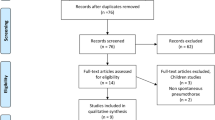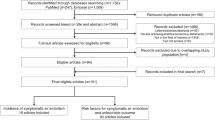Abstract
Objectives
To evaluate the outcomes of patients receiving image-guided percutaneous catheter drainage (PCD) for lung abscesses in terms of treatment success, major complications, and mortality as well as the predictors of those outcomes.
Methods
Embase and OVID-MEDLINE databases were searched to identify studies on lung abscesses treated with PCD that had extractable outcomes. The outcomes were pooled using a random-intercept logistic regression model. Multivariate Firth’s bias-reduced penalised-likelihood logistic regression analyses were performed to identify predictors of treatment success and complications. Methodological quality was assessed by summing scores of binary responses to items regarding selection, ascertainment of exposure and outcome, causality of follow-up duration, and reporting.
Results
From 26 studies with acceptable methodological quality (median score, 4; range, 3–5), 194 patients were included. The pooled rates of treatment success and major complications were 86.5% (95% confidence interval [CI], 78.5–91.8%; I2 = 23%) and 8.1% (95% CI, 4.1–15.3%; I2 = 26%), respectively. Four patients eventually died from uncontrolled lung abscesses (pooled rate, 1.5%; 95% CI, 0.2–11.1%; I2 = 36%). Malignancy-related abscess (odds ratio [OR], 0.129; 95% CI, 0.024–0.724; p = .022) and the occurrence of a major complication (OR, 0.065; 95% CI, 0.02–0.193; p < .001) were significant predictors of treatment failure. Traversing normal lung parenchyma was the only significant risk factor for major complications (OR, 27.69; 95% CI, 7.196–123.603; p < .001).
Conclusion
PCD under imaging guidance was effective for lung abscess treatment, with a low complication rate. Traversal of normal lung parenchyma was the sole risk factor for complications, and malignancy-related abscesses and the occurrence of major complications were predictors of treatment failure.
Key Points
• The pooled treatment success rate of PCD for lung abscess was reasonably high (86.5%); malignancy-related abscesses and the occurrence of a major complication were predictors of treatment failure.
• The pooled rate of percutaneous transthoracic catheter drainage-related major complications was 8.1% and traversing normal lung parenchyma by the catheter was the only risk factor.
• The pooled mortality rate from uncontrolled lung abscesses with percutaneous transthoracic catheter drainage was low.





Similar content being viewed by others
Abbreviations
- BPF:
-
Bronchopleural fistula
- CI:
-
Confidence interval
- PCD:
-
Percutaneous transthoracic catheter drainage
- PRISMA:
-
Preferred Reporting Items for Systematic Reviews and Meta-Analyses
References
Monaldi V (1956) Endocavitary aspiration in the treatment of lung abscess. Dis Chest 29(2):193–201
Wali SO (2012) An update on the drainage of pyogenic lung abscesses. Ann Thorac Med 7(1):3–7
Shim C, Santos GH, Zelefsky M (1990) Percutaneous drainage of lung abscess. Lung 168(4):201–207
Klein JS, Schultz S, Heffner JE (1995) Interventional radiology of the chest: Image-guided percutaneous drainage of pleural effusions, lung abscess, and pneumothorax. AJR Am J Roentgenol 164(3):581–588
Matarese A, Tamburrini M, Desai U, Zuccon U (2020) Percutaneous lung abscess drainage: revisiting the old gold standard. Monaldi Arch Chest Dis. https://doi.org/10.4081/monaldi.2020.1214
Hirshberg B, Sklair-Levi M, Nir-Paz R, Ben-Sira L, Krivoruk V, Kramer MR (1999) Factors predicting mortality of patients with lung abscess. Chest 115(3):746–750
Takayanagi N, Kagiyama N, Ishiguro T, Tokunaga D, Sugita Y (2010) Etiology and outcome of community-acquired lung abscess. Respiration 80(2):98–105
Kuhajda I, Zarogoulidis K, Tsirgogianni K et al (2015) Lung abscess-etiology, diagnostic and treatment options. Ann Transl Med 3(13):183. https://doi.org/10.3978/j.issn.2305-5839.2015.07.08
Wang J-L, Chen K-Y, Fang C-T, Hsueh P-R, Yang P-C, Chang S-C (2005) Changing bacteriology of adult community-acquired lung abscess in Taiwan: Klebsiella pneumoniae versus anaerobes. Clin Infect Dis 40(7):915–922
Ghosh M, Sinha Ray A, Abdin H, Al-azzawi H, Butnariu D (2015) Bronchopleural fistula with massive subcutaneous emphysema following early percutaneous drainage of lung abscess-a case report. Am J Respir Crit Care Med 191:A1843
Duncan C, Nadolski GJ, Gade T, Hunt S (2017) Understanding the lung abscess microbiome: outcomes of percutaneous lung parenchymal abscess drainage with microbiologic correlation. Cardiovasc Intervent Radiol 40(6):902–906
Moreira JDS, Camargo JDJP, Felicetti JC, Goldenfun PR, Moreira ALS, Porto NDS (2006) Lung abscess: analysis of 252 consecutive cases diagnosed between 1968 and 2004. J Bras Pneumol 32(2):136–143
Weissberg D (1984) Percutaneous drainage of lung abscess. J Thorac Cardiovasc Surg 87(2):308–312
Chae J, Kern R, Nelson D, Mullon J (2018) Diffuse large B cell lymphoma with superimposed lung abscess: potential role for intracavitary fibrinolytic therapy through a percutaneous drain to facilitate lung abscess drainage. BMJ Case Rep. https://doi.org/10.1136/bcr-2018-225670
Parker LA, Melton JW, Delany DJ, Yankaskas BC (1987) Percutaneous small bore catheter drainage in the management of lung abscesses. Chest 92(2):213–218
van Sonnenberg E, D ' Agostino HB, Casola G, Wittich GR, Varney RR, Harker C (1991) Lung abscess: CT-guided drainage. Radiology 178(2):347–351
Hong BK, Chang JH, Kim SK, Kim SK, Lee WY (1993) Cavitary lung abscess mistaken for pneumothorax after drainage of pus. Tuberc Respir Dis 40(4):449–453
Boon ES, Grupa N, Langenberg CJM, Schreij G (1996) Concealed lung abscess in critically ill, mechanically ventilated patients. Neth J Med 48(3):100–104
Jabłoński S, Modrzewski W, Rysz J, Machała W, Jabłonowski Z, Kordiak J (2006) Pulmonary abscesses - aetiology and treatment. Ten-year experience of the Department of General and Thoracic Surgery in Lodz, Poland. Arch Med Sci 2(1):47–54
Yunus M (2009) CT guided transthoracic catheter drainage of intrapulmonary abscess. J Pak Med Assoc 59(10):703–709
Rice TW, Ginsberg RJ, Todd TR (1987) Tube drainage of lung abscesses. Ann Thorac Surg 44(4):356–359
Keller FS, Rosch J, Barker AF, Dotter CT (1982) Percutaneous interventional catheter therapy for lesions of the chest and lungs. Chest 81(4):407–412
Mengoli L (1985) Giant lung abscess treated by tube thoracostomy. J Thorac Cardiovasc Surg 90(2):186–194
Rami-Porta R, Bravo-Bravo JL, Alix-Trueba A, Serrano-Munoz F (1985) Percutaneous drainage of lung abscess. J Thorac Cardiovasc Surg 89(2):314
Yellin A, Yellin EO, Lieberman Y (1985) Percutaneous tube drainage: the treatment of choice for refractory lung abscess. Ann Thorac Surg 39(3):266–270
Lambiase R, Deyoe L, Cronan J, Dorfman G (1992) Percutaneous drainage of 335 consecutive abscesses: results of primary drainage with 1-year follow-up. Radiology 184(1):167–179
Ha HK, Kang MW, Park JM, Yang WJ, Shinn KS, Bahk YW (1993) Lung abscess. Percutaneous catheter therapy. Acta Radiol 34(4):362–365
Kim GH, Hwang YS, Kim HJ (1994) Percutaneous drainage of lung abscess and infected bulla. Tuberc Respir Dis 41(2):120–126
Johnson KM, Huseby JS (1997) Lung abscess caused by Lengionella micdadei. Chest 111(1):252–253
Prasad B, Shashirekha TSC, Kasthuri AS (1998) Management of lung abscess with pervutaneous catheter drainage. Med J Armed Forces India 54(2):134–136
Shimizu J, Arano Y, Adachi I, Ikeda C, Ishikawa N, Ohtake H (2009) Intractable lung abscess successfully treated with cavernostomy and free omental plombage using microvascular surgery. Gen Thorac Cardiovasc Surg 57(11):616–621
Singhal S, Lakhkar BN (2009) Ruptured lung abscess: often a result of delayed diagnosis and treatment. Respir Med CME 2(2):73–76
Kelogrigoris M, Tsagouli P, Stathopoulos K, Tsagaridou I, Thanos L (2011) CT-guided percutaneous drainage of lung abscesses: review of 40 cases. JBR-BTR 94(4):191–195
Gaballah AA, Elgazzar AEM, Elshahat HM, Yusuf ARI, Takwa H (2018) The role of ultrasound-guided nephrostomy catheter drainage in the management of peripheral pyogenic lung abscess. Egypt J Chest Dis Tuberc 67(1):38–45
Carvalho JS, Marques DP, Oliveira I, Vieira AC (2019) Unusual case of a giant lung abscess initially misdiagnosed and treated as an empyema. BMJ Case Rep. https://doi.org/10.1136/bcr-2018-228849
Oh M, Mori S, Noda Y, Kato D, Ohtsuka T (2020) Effective exchange to a larger size catheter for a lung abscess with initial percutaneous drainage failure: a case report. Surg Case Rep. https://doi.org/10.1186/s40792-020-00828-7
Murad MH, Sultan S, Haffar S, Bazerbachi F (2018) Methodological quality and synthesis of case series and case reports. BMJ Evid Based Med 23(2):60–63
Stijnen T, Hamza TH, Özdemir P (2010) Random effects meta-analysis of event outcome in the framework of the generalized linear mixed model with applications in sparse data. Stat Med 29(29):3046–3067
Brown SG, Ball EL, Perrin K et al (2020) Conservative versus interventional treatment for spontaneous pneumothorax. N Engl J Med 382(5):405–415
Hunter JP, Saratzis A, Sutton AJ, Boucher RH, Sayers RD, Bown MJ (2014) In meta-analyses of proportion studies, funnel plots were found to be an inaccurate method of assessing publication bias. J Clin Epidemiol 67(8):897–903
Schweigert M, Dubecz A, Beron M, Ofner D, Stein H (2013) Surgical therapy for necrotizing pneumonia and lung gangrene. Thorac Cardiovasc Surg 61(7):636–641
Delarue N, Pearson F, Nelems J, Cooper J (1980) Lung abscess: surgical implications. Can J Surg 23(3):297–302
Estrera AS, Platt MR, Mills LJ, Shaw RR (1980) Primary lung abscess. J Thorac Cardiobasc Surg 79(2):275–282
Nissen T, Wynn R (2014) The clinical case report: a review of its merits and limitations. BMC Res Notes 7:264. https://doi.org/10.1186/1756-0500-7-264
Acknowledgements
There are no acknowledgements for this article. This research did not receive any specific grant from funding agencies in the public, commercial, or not-for-profit sectors.
Funding
The authors state that this work has not received any funding.
Author information
Authors and Affiliations
Corresponding author
Ethics declarations
Guarantor
The scientific guarantor of this publication is Chang Min Park.
Conflict of Interest
The authors of this manuscript declare no relationships with any companies whose products or services may be related to the subject matter of the article.
Statistics and biometry
One of the authors has significant statistical expertise (Hyunsook Hong, Ph.D.; Medical Research Collaborating Center)
Informed consent
Written informed consent was not required because this study is systematic review and meta-analysis.
Ethical approval
Institutional Review Board approval was not required because this study is systematic review and meta-analysis.
Study subjects or cohorts overlap
This study is systematic review of the literature and meta-analysis of all their patients.
Methodology
• retrospective
• diagnostic or prognostic study
• multicenter study
Additional information
Publisher’s note
Springer Nature remains neutral with regard to jurisdictional claims in published maps and institutional affiliations.
Supplementary information
Supplementary Table 1
(DOCX 21 kb)
Rights and permissions
About this article
Cite this article
Lee, J.H., Hong, H., Tamburrini, M. et al. Percutaneous transthoracic catheter drainage for lung abscess: a systematic review and meta-analysis. Eur Radiol 32, 1184–1194 (2022). https://doi.org/10.1007/s00330-021-08149-5
Received:
Revised:
Accepted:
Published:
Issue Date:
DOI: https://doi.org/10.1007/s00330-021-08149-5




